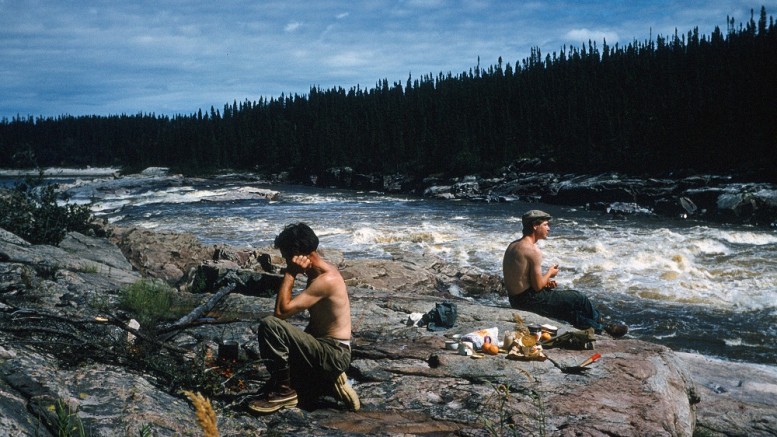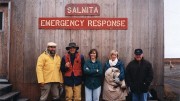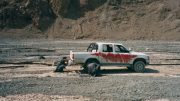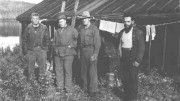I spent my first summer in the bush in 1958, soon after graduating from MIT with a bachelor’s degree in geology and geophysics. McPhar Geophysics had hired me as chief of a three-man field party to locate and detail airborne electromagnetic anomalies on the ground.
The project was organized by a well-known Toronto consultant, Dr. A.W. “Dink” Derby, and our area was the Evans Lake greenstone belt in northwestern Quebec, 150 miles north of the Fecteau air base in Senneterre. Evans Lake was the next greenstone belt north of the Mattagami greenstone belt, where recent drill holes were reported to have discovered an orebody.
I spent one and a half years, summer and winter, in the Evans Lake area with different crews but often with an experienced bushman, Angus Wilbur, and a young helper, Vernon Smith. Angus was a quiet, competent and reliable tent mate who taught me much about bush craft.
I was green but I learned fast, of necessity, and tried not to make the same mistake twice. The contrast with the student life I’d led for four years was total and I enjoyed it immensely. I liked the outdoor life, the strenuous physical efforts required, and the sense of adventure and discovery as I learned to live with the wilderness and relative solitude. I also enjoyed the break from homework and chance to get a full night’s sleep every night without a test somewhere in the future.
All of the old bushmen and prospectors were storytellers, although their talents varied. Mostly this came from practice born of necessity. On the many long, rainy tent days, on canoe trips and during smoke breaks on the trail, there were stories.
In the bush, one came to know a person in an unusual way. The past of another person was rarely mentioned as a personal history, but rather took the form of stories about past events, often humorous. In the purely personal historical sense, you didn’t get to know a person as well in the bush as in civilization. But this was probably because such things were not as important in the bush.
We operated by the old frontier idea of every man on his present merits. The history of one’s jobs or family background was less important than the question of “Will he do his share?”
Bushmen tended to be agreeable under most circumstances and good-natured generally. If one spent any time in the bush this became a virtual necessity. In four months of 24-hour days, living in a tent under difficult and primitive conditions, you learned when to maintain silence or to inject humour during your partner’s bad moods. When blowups occurred — and they did — the sooner forgotten or ignored the better.
Angus Wilbur sometimes talked about his time in a Japanese prison. It was obviously a very grim experience, but his quiet sense of humour made light of the horror and he seemed to bear no grudges. He and his brother grew up in Bathurst, N.B., joined the army as young men and were shipped out to Hong Kong, where they were soon captured by the Japanese in December 1941.
He spent most of WWII in a prison camp in Japan and his brother died there of starvation. Angus said the big and healthy died first. He told of sleeping on the floor of a crowded room with other prisoners and speculating about which bed would next be empty and available when its sick occupant died. He was fortunate to have lost only a big toe, which barely hampered him in the bush.
After capture, the Japanese lined up the prisoners and made them count off in Japanese. After the first time, if a prisoner got the number wrong they were jabbed with a bayonet. Angus said it was amazing how fast you could learn a foreign language.
The prisoners were responsible for their camp discipline, and one night the Japanese caught Angus asleep on guard duty. The ranking prisoner, I think a Canadian major, insisted that he was responsible for discipline and held a court hearing while the Japanese guards watched, only partly comprehending. After hearing the evidence, the major sternly told a very scared Angus that what he had done was unforgivable and as punishment ordered that his candy bar ration be suspended for three months. Angus said he hadn’t seen a candy bar in three years.
After the war was over but before the U.S. troops arrived, much food was dropped by air. There was still awe and amazement in Angus’s voice, 14 years later, as he described what happened when he saw a sack of flour dropped from a B-29 hit a Japanese woman on a bicycle.
He also had stories of people and events in his hometown of Bathurst. He regaled us with a story of his futile efforts to convince a game warden that the illegal moose hanging on his back porch was really a side of beef. And how he filled a piece of firewood with black powder to cure a neighbour of stealing his firewood. A few weeks later he heard a satisfying boom and saw a cloud of black smoke billowing from where his neighbour’s stovepipe had been.
Angus and I flew out of the bush to Amos in mid-September 1959, and I took the first overnight train to Toronto. Angus showed up at McPhar’s office a day later, about noon, with a serious hangover. It seemed that the stationmaster at Rouyn had noticed Angus’s Hong Kong pin, called some guys that had been with him and they had a very big party. It was a perfect end to the field season for this quiet Canadian hero.

— Dr. Harold Linder is an exploration geologist who has worked on all seven continents and is now retired in Anthem, Arizona. He discovered the giant, unmined Schaft Creek porphyry copper-molybdenum deposit in northern B.C. in 1968 for Hecla Mining. In 1986 he discovered the Castle Mountain gold deposit in the Mojave Desert of southern California for Viceroy Resources, which produced over 1.25 million oz. gold between 1992 and 2001. This is an excerpt from his new memoir, Wild Places: The Adventures of an Exploration Geologist, available at amazon.ca or amazon.com.





Be the first to comment on "Odds ‘n’ Sods: An introduction to bush life"